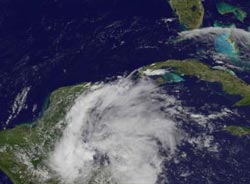Second Atlantic season tropical depression forms

Tropical Depression 2 formed in the western Caribbean Sea during the early afternoon hours (Eastern Daylight Time) on June 17. NOAA's GOES-13 satellite captured an image of the storm as it consolidated enough to become a tropical depression while approaching the coast of Belize.<br><br>Credit: NASA GOES Project/NASA's Goddard Space Flight Center<br>
NOAA's GOES-13 satellite sits in a fixed orbit and monitors the weather in the eastern half of the continental United States and the Atlantic Ocean. NASA's GOES Project at NASA's Goddard Space Flight Center in Greenbelt, Maryland uses the data from GOES-13 and creates imagery. NASA's GOES Project created an image of Tropical Depression 2 from June 17 at 1:10 p.m. EDT.
Looking closely at the imagery, strong thunderstorms are firing up around the center of circulation, just off-shore from Belize. The clouds associated with the depression stretch much farther, from far western Cuba, to the eastern Yucatan Peninsula, and over Belize and Honduras.
The National Hurricane Center designated the low pressure area as Tropical Depression 2 at 11 a.m. EDT. At that time it had maximum sustained winds near 35 mph (55 kph) and was moving to the west-northwest at 13 mph (20 kph). Tropical Depression 2 is located near 16.2 north and 87.6 west, about 60 miles (95 km) east of Monkey River Town, Belize.
The center of the depression will move inland over southern Belize this afternoon where no change in strength is expected as it moves over land. The depression could emerge into the Bay of Campeche on Tuesday, according to the National Hurricane Center (NHC). NHC noted that an increase in strength is possible on Tuesday if the center emerges into the Bay of Campeche. If that happens, Tropical Depression 2 could become Tropical Storm Barry.
Media Contact
More Information:
http://www.nasa.govAll latest news from the category: Earth Sciences
Earth Sciences (also referred to as Geosciences), which deals with basic issues surrounding our planet, plays a vital role in the area of energy and raw materials supply.
Earth Sciences comprises subjects such as geology, geography, geological informatics, paleontology, mineralogy, petrography, crystallography, geophysics, geodesy, glaciology, cartography, photogrammetry, meteorology and seismology, early-warning systems, earthquake research and polar research.
Newest articles

High-energy-density aqueous battery based on halogen multi-electron transfer
Traditional non-aqueous lithium-ion batteries have a high energy density, but their safety is compromised due to the flammable organic electrolytes they utilize. Aqueous batteries use water as the solvent for…

First-ever combined heart pump and pig kidney transplant
…gives new hope to patient with terminal illness. Surgeons at NYU Langone Health performed the first-ever combined mechanical heart pump and gene-edited pig kidney transplant surgery in a 54-year-old woman…

Biophysics: Testing how well biomarkers work
LMU researchers have developed a method to determine how reliably target proteins can be labeled using super-resolution fluorescence microscopy. Modern microscopy techniques make it possible to examine the inner workings…





















